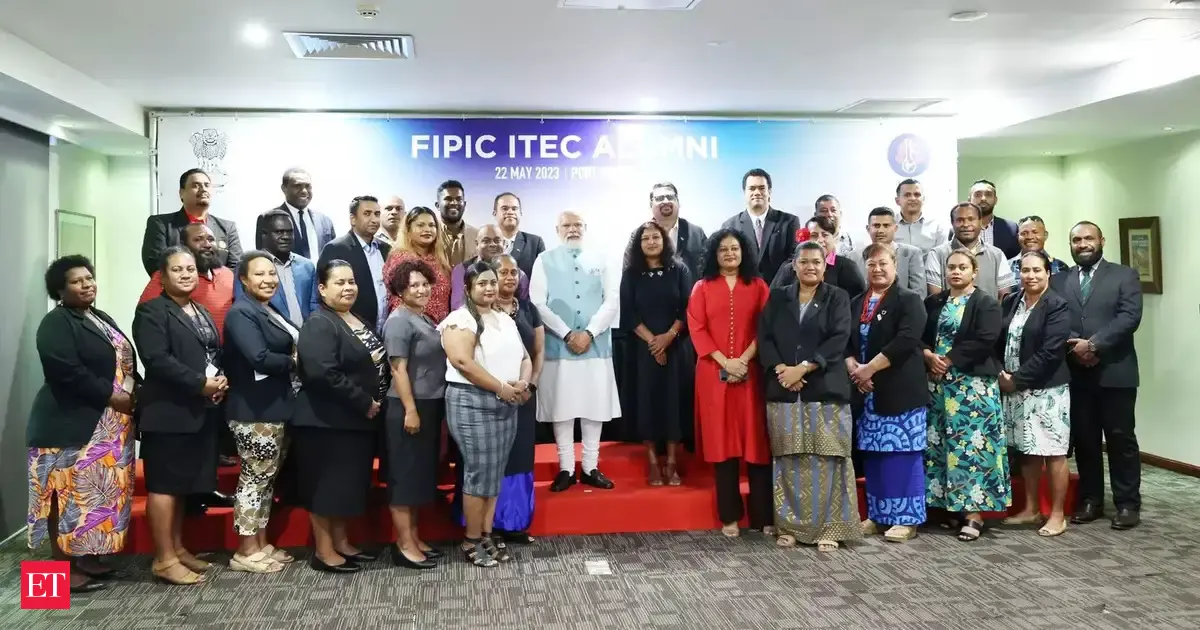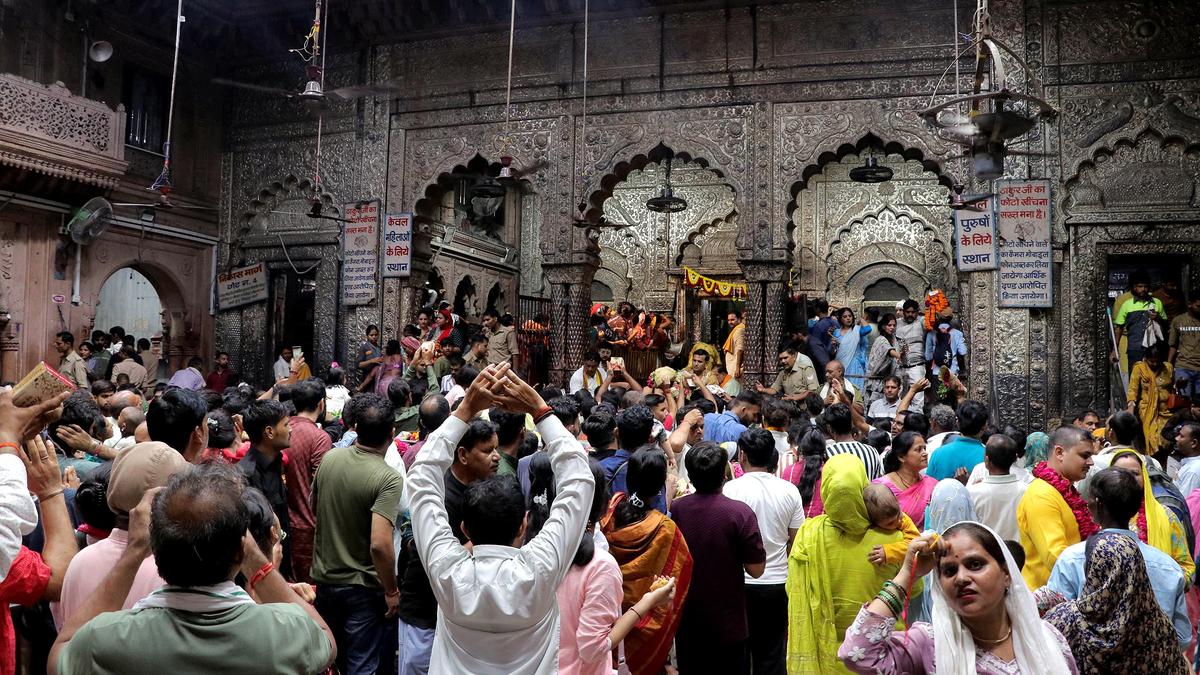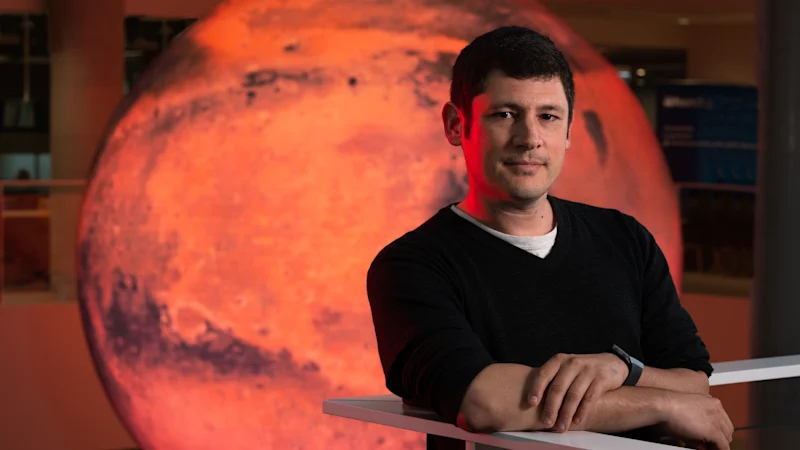By Dipanjan Roy Chaudhury
Copyright indiatimes

PM Modi with the alumni of the ITEC network from Pacific Island Countries in 2023.
Launched in 1964, the Indian Technical and Economic Cooperation (ITEC) programme marks six decades of India’s transformation from being one of the world’s largest aid recipients to becoming a trusted provider of development assistance. Anchored in the principles of South-South Cooperation (SSC) – solidarity, equality, respect for sovereignty, and non-conditionality-ITEC stands today as the flagship of India’s International Development Partnerships (IDP).Over the years, it has trained more than 4,15,000 participants from 161 countries, offering over 380 courses annually in diverse fields,including agriculture, Information and Communication Technology (ICT), governance, renewable energy, maritime security, and climate resilience. To capture this in its entirety a recently a book was published. The book ITEC at 60: India’s International Development Partnerships seeks to document this long and complex history. It examines ITEC’s origins, its institutionalisation, its place within India’s foreign policy, and its contribution to South-South Cooperation (SSC). It also explores the challenges and opportunities for the programme’s future.Authored by Maria Elizabeth Joseph, Swati Sinha, and Dr. ShimreisaChahongnao, the book was published by the leading public policy think tank Ananta Aspen Centre with the support of the Gates Foundation (formerly the Bill & Melinda Gates Foundation). The book is a valuable addition to the discourse on international development and will serve as a reference for the Ministry of External Affairs, and embassies of partner countries across the Global South.Live EventsThe Indian Technical and Economic Cooperation (ITEC) programme, launched in 1964, represents a remarkable journey of India’s transformation from one of the largest recipients of foreign aid in the mid-twentieth century to a net provider of development assistance in the 21st century. Rooted in India’s philosophy of solidarity, self-reliance, and respect for sovereignty, ITEC has become a flagship initiative of India’s International Development Partnerships (IDP). Over six decades, it has provided training to more than 4,15,000 participants from 161 countries, covering diverse fields such as agriculture, ICT, public administration, renewable energy, governance, climate resilience, and maritime security. Even before independence, India had begun to share knowledge and resources with neighbouring countries. In 1946, Pandit Jawaharlal Nehru invited students from countries like Indonesia and China to study at the Indian Council of Agricultural Research. By 1949, India was already offering 75 scholarships on a bilateral basis.In the early 1950s, India formalised its support to other developing nations through programmes like the Special Commonwealth Assistance for Africa Programme (SCAAP)and the Colombo Plan. These laid the foundation for a distinct model of international development cooperation that emphasised equality, mutual benefit, and solidarity rather than conditionality or political leverage.The decisive step came on 15September 1964, when the Government of India formally established ITEC through a Cabinet decision. At that time, India was itself a recipient of large-scale foreign aid. Yet it chose to create an institutional mechanism to share its modest but growing expertise with other newly decolonised nations.Unlike the donor–recipient framework of North–South aid, ITEC was demand-driven and entirely funded by the Government of India. Partner countries identified their needs, and India responded with customised capacity-building programmes, technical assistance, and expert deployments. This approach quickly resonated with countries of the Global South.During its early decades, ITEC supported partner countries by sending Indian experts abroad. For example, coconut plantation specialists to Fiji or feasibility study teams for fisheries, sugar, and cashew cultivation in Africa. It also trained civil servants, engineers, doctors, and administrators in Indian institutions.The Cold War period deeply shaped ITEC’s orientation. India, committed to non-alignment, used the programme to strengthen ties with countries in Asia, Africa, and Latin America while avoiding alignment with either superpower. By offering technical and economic assistance without political strings, India built goodwill and credibility.The 1970s and 1980s witnessed expansion in scope and geography. New partnerships were established with countries like Burma, Cuba, Mexico, and Peru. India extended ITEC to the Gulf, West Africa, and North Africa, focusing on sectors such as healthcare, railways, and the oil industry.By the mid-1980s, more than 8,000 Africans were being trained in Indian institutions annually. The programme also began engaging with multilateral platforms such as the African Development Bank (AfDB) and the Economic Community of West African States (ECOWAS). Despite economic constraints and external pressures, India kept ITEC active, reflecting its long-term vision of South-South solidarity.The post-1991 era of economic liberalisation gave fresh impetus to ITEC. As India’s economic and diplomatic profile expanded, ITEC was increasingly viewed as part of a broader “development compact” that encompassed concessional finance, grants, technology transfer, and trade facilitation.In 1995, the Ministry of External Affairs (MEA) created a dedicated Technical Cooperation Division, signalling institutional strengthening. SCAAP and Colombo Plan activities were brought under ITEC’s umbrella in 1999.Even after sanctions following India’s 1998 nuclear tests, New Delhi expanded ITEC, offering more training slots and introducing new courses in areas like pharmaceuticals and remote sensing. The late 1990s and 2000s also saw the emergence of ITEC Alumni Associations, strengthening networks of influence across partner countries.By 2012, ITEC had become central to India’s international development cooperation, widely recognised as a flagship of South-South Cooperation.A major milestone came in 2012 with the establishment of the Development Partnership Administration (DPA) within MEA. DPA was created to streamline India’s growing international development portfolio. ITEC was placed under DPA-II, which became the nodal division for capacity-building initiatives.The DPA introduced innovations — e-ITEC: Online courses to overcome geographical and logistical barriers; ITEC Onsite: Sending Indian experts and trainers to partner countries and ITEC Executive: Specialised, modular courses for senior officials.These reforms improved accessibility, addressed concerns about facilities and per diem allowances, and aligned ITEC with digital and flexible learning trends.By 2024, ITEC had trained more than 4,15,000 participants from 161 countries and was offering over 380 courses annually. ITEC faces persistent challenges. Many participants struggle with the English language. India has started offering French and Spanish courses, but linguistic inclusivity remains a hurdle. Concerns over infrastructure and standards in some institutions need systematic improvement. Many partner countries leave training slots vacant due to coordination gaps. India lacks adequate capacity in some specialised areas demanded by partners. Absence of centralised, detailed data on beneficiaries limits forecasting and impact assessment.Originally a bilateral programme, ITEC gradually expanded into multilateral frameworks by engaging with organisations like the UN Economic Commission for Africa (UNECA), the African Union Commission (AUC), and the Commonwealth Secretariat.More recently, triangular cooperation has emerged as a new mode, where India partners with a third country or institution to deliver capacity-building. For instance, collaborations with ICRISAT in agriculture or the QUAD Fellowship for Indo-Pacific nations represent this evolution.This flexibility has allowed ITEC to adapt to global shifts and remain relevant in addressing development challenges.ITEC is positioning itself to address new global priorities in AI, Climate Action and Maritime security. These innovations would not only strengthen ITEC but also reinforce India’s role as a key partner in sustainable and inclusive development.At sixty, ITEC stands as a unique example of a development cooperation programme that has endured and adapted across vastly different global and domestic contexts. ITEC continues to embody India’s commitment to solidarity, self-reliance, and South-South Cooperation, making it a vital instrument for advancing the aspirations of the Global South in an increasingly multipolar world.Add as a Reliable and Trusted News Source Add Now!
(You can now subscribe to our Economic Times WhatsApp channel)
Read More News onun economic commissiontechnical cooperation divisionsscunecasolidaritypandit jawaharlal nehrunorthsouthitecministry of external affairsmea
(Catch all the Business News, Breaking News, Budget 2025 Events and Latest News Updates on The Economic Times.) Subscribe to The Economic Times Prime and read the ET ePaper online….moreless
(You can now subscribe to our Economic Times WhatsApp channel)Read More News onun economic commissiontechnical cooperation divisionsscunecasolidaritypandit jawaharlal nehrunorthsouthitecministry of external affairsmea(Catch all the Business News, Breaking News, Budget 2025 Events and Latest News Updates on The Economic Times.) Subscribe to The Economic Times Prime and read the ET ePaper online….moreless
Prime ExclusivesInvestment IdeasStock Report PlusePaperWealth Edition123View all Stories



